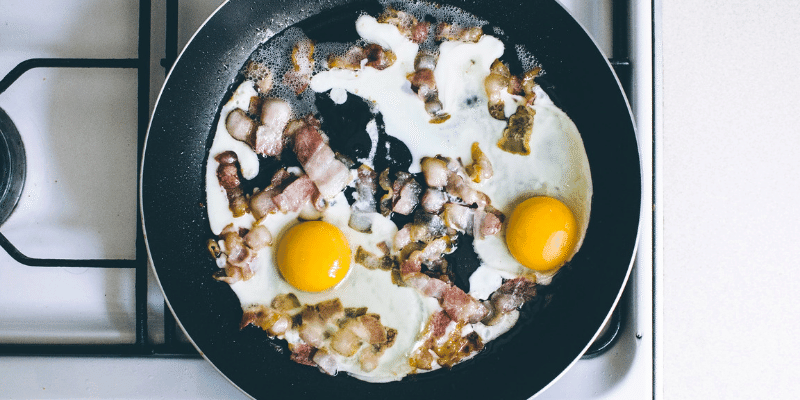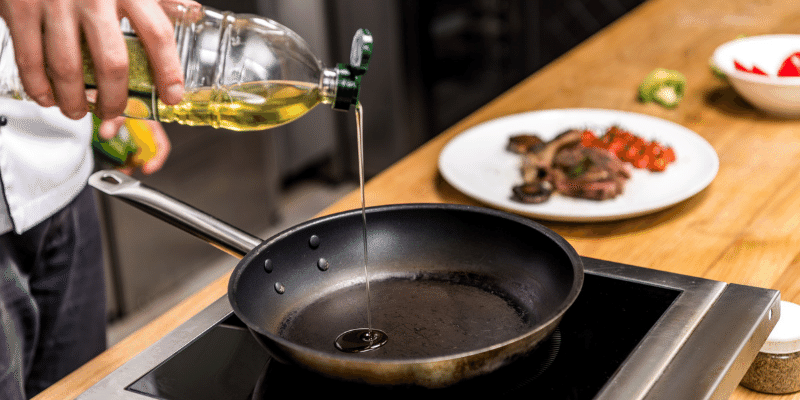Frying has been greatly demonized by fitness experts as it uses unnecessary amounts of oil to sizzle and cooks the food.
Although a quick way to rustle up delicious frittatas, fish fillets, and chicken breast, when it comes to healthy, low-fat cooking, pan-frying may not be the first option on your mind.
However, as a common cooking method around the world, is pan-frying actually healthy or not?
Recent research suggests that heating up vegetable oils over high temperatures produces acrylamide, which has been linked to the onset of cancer and heart disease.
With such worrying claims looming in the air, how do you sift out the safest way to cook your food? Well, before we get to that, let us first understand that not all frying methods are the same.
Difference between Pan Frying and Deep Frying
Any type of frying essentially requires the use of added fat to brown and cook the food down. Both pan-frying and deep-frying are done by submerging the food in searing oil.
While deep-frying requires a higher temperature, you can toss in the food anywhere near a temperature of 350 degrees during pan-frying. However, because the layer of fat is so thin, it can be harder to regulate the oil’s temperature and ensure the food cooks evenly.
Pan-frying is ideal for browning your food as it comes in contact with the surface. When you deep-fry food, you can expect a crispy golden top and a juicy center. However, food that is pan-fried is usually tender, brown, and must be flipped once or twice to cook evenly. If the temperature isn’t hot enough, pan-fried food can soak up the grease, become soggy, and taste very oily.
In the end, it really depends on what you’re frying.
Snacks like onion rings, cheese sticks, fries, and popcorn chicken must always be deep-fried to retain their crustiness and juices.
Pan-frying, on the other hand, is ideal for pork chops, bacon, pancakes, frittatas, and steaks because they need little oil.
So, we now know that pan-frying only submerges the food half-way into the oil, and requires a few tablespoons of fat at most. You will be absorbing lesser fat so long as the temperature remains uniform throughout the cooking process.
Therefore, in some ways, pan-frying, as compared to deep-frying, can be a healthier option for cooking delicate lean cuts and raw veggies provided that you cook them correctly.
How Pan-Frying Affects the Nutrient Content of Your Food
Any vegetable or meat when cooked down will result in a loss and gain of nutrients.
Cooked spinach, for example, contains a higher content of iron along with other accessible nutrients when cooked as compared when it is eaten in its raw form.
Some foods are too delicate to be roughly cooked in heated oil. Fatty fish is an apt example. Being a wonderful source of omega-3 fatty acids, it can, in fact, lose all its healthy fats if cooked at high temperatures.
Pan-frying tuna, for example, can bring down its omega-3 content by 70-80%. This is in stark contrast to baking tuna – baking only causes a minimal loss of fatty acids.
According to research published in 2009, broccoli loses most of its nutritional value when it is fried or boiled. Only lightly steaming helps it retain most of its glucosinolates.
The nutrient loss is fairly opposite in the case of potatoes. Pan-frying potato wedges, for example, will help preserve vitamins B and C and even enrich the amount of fiber.
How many nutrients are retained by the vegetable after pan-frying will inevitably depend on the kind of oil you use.
Most Mediterranean dishes cook vegetables like green peppers, eggplants, and zucchinis in olive oil. There are many anti-oxidants in olive oil, which prevent thermal degradation when cooked over high heat. However, repeated use of the same oil can deplete this capacity.
Nonetheless, there are many vegetables like Spinach, Swiss chard, and beet greens that release greater amounts of minerals and nutrients when they’re pan-fried. The high temperature releases the bound calcium, magnesium, and iron, making the nutrients more accessible for the body.
Pan-frying certainly has advantages that must be acknowledged. The reason why it’s discouraged is because of the oil that leeches into the food you cook.
Also read: What Is The Best Fish To Pan Fry?
However, are all oils really that harmful to your health?
Are Saturated Fats All Bad?
The main feature that defines healthy cooking is using as little fat as possible. But how is it that this macro-nutrient, which is so essential in our diet, should be consumed in such little amounts?
For ages, saturated fats like canola oil have been criticized by medical experts for their role in triggering heart disease and worsening obesity.
However, saturated fats are not all bad.
We direly need them in our diet as they are a building block for our cell structure and can be very satiating. They help the body absorb fat-soluble nutrients like Vitamin A and D along with omega-3 fatty acids. And, all of these consumed moderately only improve heart health instead of the opposite.
In one way, cooking your food in fats like sunflower oil, olive oil, coconut oil, and soybean protects your heart from the onset of a number of diseases.
Coming back to pan-frying your food, if you’re doing it in a healthy way, there really isn’t any threat to your health. It is only trans-fats that you should steer clear of as they are extremely detrimental to your cholesterol levels.
Foods like doughnuts, muffins, and crackers are usually fried in hydrogenated vegetable oils, which is what can throw off the cholesterol levels in your body.
However, pan-frying is completely different.
If you’re using the right amount of oil and are cooking your food at the right temperature, pan-frying is not unhealthy at all. As long as you’re consuming everything in moderation, you shouldn’t worry about the fat content. Weight watchers may replace canola and sunflower with olive or coconut oil but completely eliminating oils from your diet can do more harm than good.
So, with all the information we have gathered, here’s what we know: pan-frying isn’t all that bad and unhealthy. However, there are certainly many ways to make it healthier and more wholesome for a nutritious diet.
Tips to Make Pan-Frying Super-Healthy
Many fried foods are cooked in oils that are exceptionally high in omega-6 fatty acids, which can cause inflammation in the body. Sometimes, frying these oils and re-using them can oxidize and alter their compound structure, which can be harmful at a cellular level. But, there are many ways to avoid this unwanted outcome.
While, you can always resort to baking, steaming, or air-frying as good alternative to pan-frying, if you still like to sizzle your steaks in a hot pan, then here are some tips for healthy pan-frying.
Start with the Right Oil
Always cook with a healthy and heat-stable oil that can withstand temperatures up to 500 degrees. Even when olive oil is a healthy choice, it is highly unstable and oxidizes fairly quicker than canola or sunflower oil.
Hence, foods like fritters and potato pancakes are best cooked in canola as they will need a longer time to soften up.
Another great option is avocado oil, which has over 70% of heart-healthy monounsaturated fats. You can also coconut oil, which has a higher smoke point than olive oil in combination with canola and avocado oils.
Using a Moderate Amount of Oil
The second tip to heed is not to over-use oil, even when it’s heart-healthy. When pan-frying, moderation is key.
Ideally, your pan should have an inch of oil, regardless of whatever you’re cooking.
Be mindful of the size of your pan as wider cookware will require that you distribute the oil evenly. However, don’t be a miser and use only a tablespoon.
Make sure to cover the pan with an entire layer of oil to ensure that your food doesn’t burn and turn out crispy.
Use Clean Oil
Don’t re-use cooking oil more than two or three times because that can lead to the growth of toxic chemicals that are unsafe to consume.
When you’re pan-frying any food, you will notice some food debris or batter coating swimming on the surface. If you cook it long enough, it will char and produce harmful by-products.
A solution to this is to clean out the oil using a sift or simply spoon out the residue using a big spatula.
Be Mindful of the Cooking Temperature
While pan-frying, maintain a temperature of up to 325 F for uniform cooking.
You can even use a try using a thermometer initially to get an idea of how long you should be heating up the oil in the pan.
The oil that isn’t hot enough won’t cook through your food, leaving a greasy film over it, so be careful with the numbers.
Use the Right Cookware
Your two best options when pan-frying meat or veggies is either a stainless steel pan or a well-seasoned cast-iron pan. You can use these over gas, electric, as well as on an induction cooktop,
Avoid using nylon spatulas as the food residue tends to stick to them.
Instead, use metal tongs or metal slotted spoons to flip the food and cook it nicely.
Don’t Pan-Fry Too Many Things at Once
There may be chances that your oil may have not heated up that well, and if you were to crown it with a lot of food items, the moisture will build up causing your food to soak up all the oil.
This will also lead to steam, which can lead to soggy, greasy food.
Now that you know all the necessary tips to pan-fry in the healthiest way, it’s time to enjoy your favorite pan-fried recipes without feeling guilty.
You may also like the following articles:


